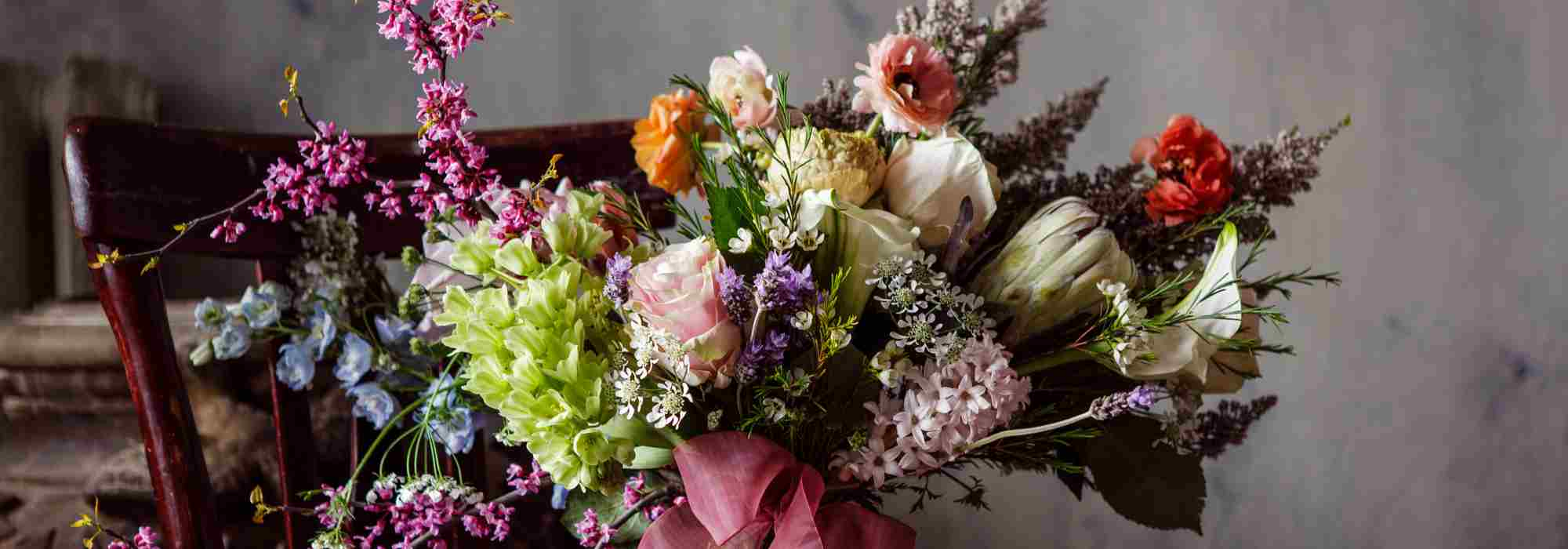
The most beautiful perennials for homemade bouquets
Flowers for making homemade bouquets easily
Contents
Whether you have a large garden or just a small outdoor space, it is entirely possible to grow flowers for cutting. perennials for bouquets are among these ideal candidates, with multiple assets. Let’s see how to choose them well and succeed in making homemade bouquets.
The benefits of perennials for beautiful homemade bouquets
Perennial plants are essential in the garden. Indeed, they boast numerous qualities.
- They are long-lasting. Unlike annuals, whose life cycle lasts only a few months, perennials are enduring, remaining in the garden or in pots for several years.
- There is a great diversity of perennial plants, to suit all tastes and styles. Vibrant or pastel colours, single or more sophisticated flowers, upright or ground-covering habit, colourful foliage, ornamental fruiting, etc.
- They are versatile. In the ground or in pots, in rockeries, on slopes, in borders, in hedges…
- You will certainly find perennials that tolerate your garden’s growing conditions: in sun or shade, in heavy or light soil, in acidic or alkaline pH, in dry or damp areas, that withstand harsh winters, etc.
- They are often easy to grow, as long as their requirements are taken into account.
- Many of them propagate easily. This is a great way to green up your garden at low cost and with little effort.
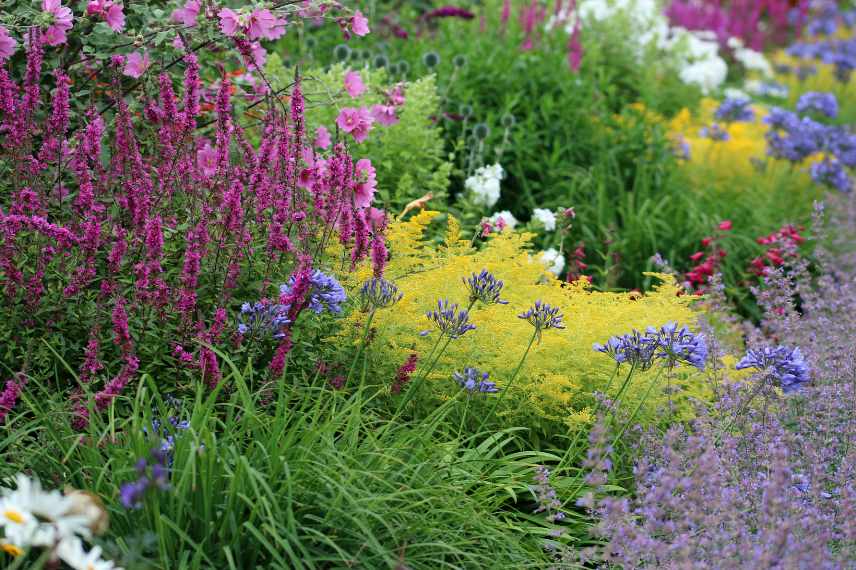
Perennials create wonderful flower beds that you’ll never tire of!
Why growing perennials for bouquets?
Growing your own cut flowers in the garden has nothing but advantages.
First of all, it’s beautiful! Bouquet flowers have outstanding ornamental qualities, which will dress up and brighten the garden in almost every season. The first argument is purely aesthetic.
Secondly, it’s economical. Buying a bouquet can be expensive, especially when opting for sophisticated arrangements combining several types of flowers. To decorate your home or to give as a gift, growing cut flowers allows you to save money by making your own bouquets. And perennials are often generous, sometimes flowering for months. You can therefore easily refresh your bouquets.
Moreover, it’s eco-friendly. Most cut flowers sold worldwide are mass-produced thousands of miles away, using numerous pesticidal products. Add to that the impact of transport and heated greenhouses, which ultimately make the bouquet flower market a polluting industry. By growing them yourself, you know exactly how your flowers are cultivated (meaning they can thrive without any chemicals). You also ensure you respect seasonality!
Of course, it’s a fun and rewarding activity, with the pleasure of harvesting your own flowers to create beautiful bouquets!
When choosing perennials, follow your preferences, but also consider your growing conditions:
- type of soil (light, heavy, clay, acidic, chalky, dry, moist…);
- exposure (sunny, dappled shade, dark…);
- climate (dry, humid, cold, windy…);
- growing area (in the ground, in pots, in rockeries, etc.).
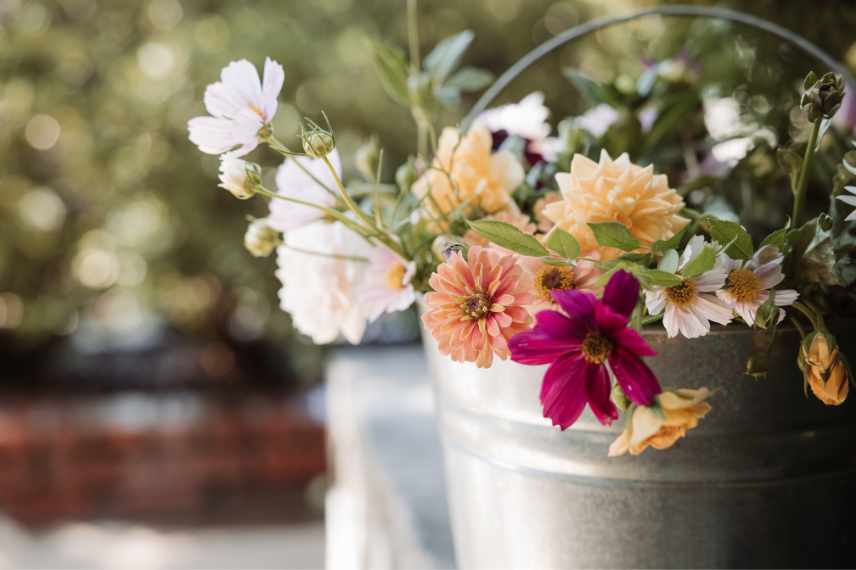
Perennials, along with some annuals, allow for countless pastel or more vibrant combinations
Perennials for beautiful flower bouquets all year round
Perennials offer us a wide choice of flowers for bouquets all year round. Remember to choose them carefully according to their flowering period to stagger them and enjoy beautiful homemade bouquets throughout the year.
In spring
For creating beautiful spring bouquets, you’ll be spoilt for choice with perennials. Let’s start with peonies, essential in bouquets. With single or double flowers, in vibrant or more timid colours, with a natural or sophisticated look… You’re bound to find varieties you love!
Next come the bleeding hearts, adorable perennials that produce pendulous heart-shaped flowers.
The quintessential May flower, lily of the valley, also makes beautiful bouquets with its distinctive white bell-shaped flowers.
Bergenias, beautiful groundcover plants with lush foliage, also offer lovely bouquet flowers in the form of small bells, appearing in late winter or early spring.
Let’s not forget the original flowering of spurges, often in green to yellow hues.
For a slightly retro charm, consider columbines, with their abundant flowering in a wide range of colours.
Primroses, among the first flowers of the year, are also a must.
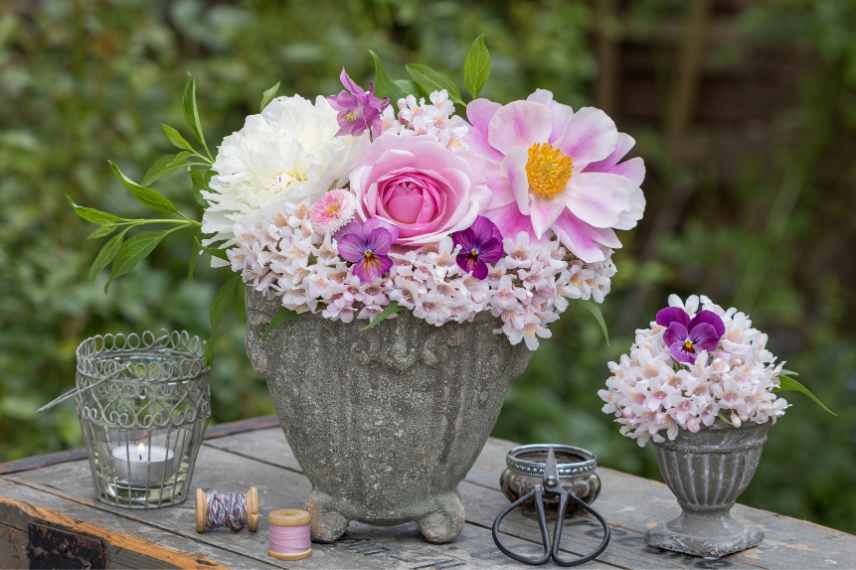
Peonies are the stars of spring bouquets, here paired with some columbines, roses, pansies and Kolkwitzia amabilis flowers
In summer
During the summer months, gardens explode with flowers. The hardest part will be choosing which flowers to cut for bouquets! Here are some perennial bouquet favourites to adopt without hesitation:
- lupins, with their tall colourful flower clusters;
- purpletop vervain, with its airy purple panicles;
- rudbeckias, with their colourful flowers and prominent centres;
- astilbes, with their magnificent feathery inflorescences;
- delphiniums, producing long flower spikes;
- pinks, generous and colourful perennials;
- foxgloves, with their impressive bell-shaped flowers;
- perennial sages, with their long colourful flowering;
- yarrows, easy-going perennials with colourful umbel flowers;
- blanket flowers, equally generous and colourful;
- daylilies, ephemeral but prolific;
- alstroemerias, with exotic-looking flowers that last long in vases;
- baby’s breath, whose ethereal flowering is often used by florists in bouquets;
- etc.
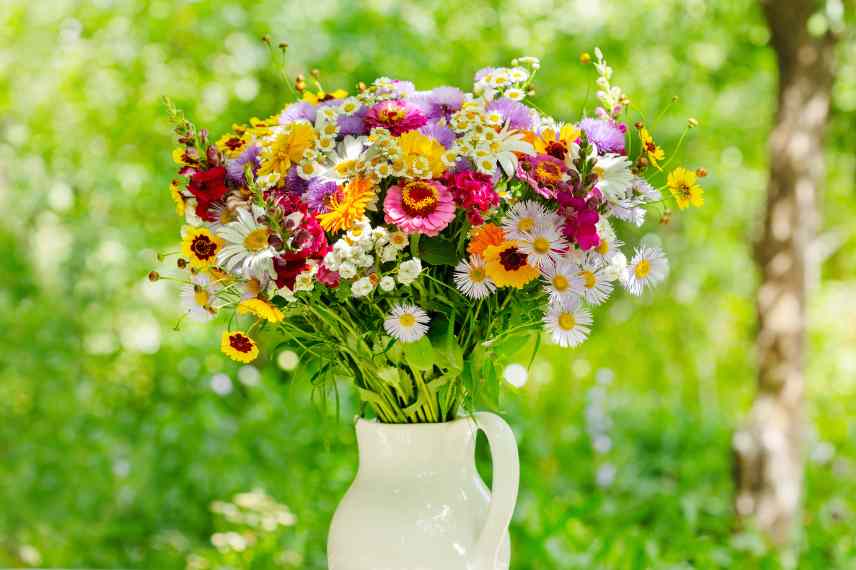
In summer, the choice is immense among garden perennials, often in warm, sunny tones
In autumn
Autumn doesn’t mark the end of flowering. Many perennials wait for temperatures to drop slightly before revealing their blooms. This is the case with autumn sedums, with their superb colourful umbel inflorescences.
We should also mention Japanese anemones, which brighten up late summer and autumn.
Let’s not forget asters, the kings of autumn with their daisy-like flowers offering a beautiful palette of colours.
Finally, let’s rescue chrysanthemums from cemeteries and give them a place in our autumn bouquets.
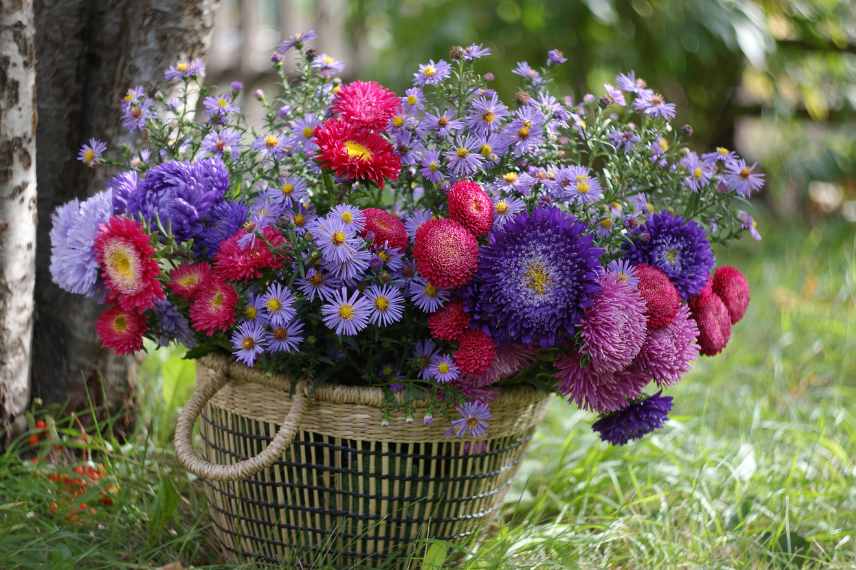
Michaelmas daisies and asters reach their peak in autumn, forming the basis of many bouquets even in this season
In winter
Although this period is often seen as the dullest in the garden, some plants take advantage of the lack of competition to delight us with their flowers. This is particularly true of hellebores, evocatively named Christmas roses or Lenten roses depending on their flowering period.
Some primroses also flower as early as January.
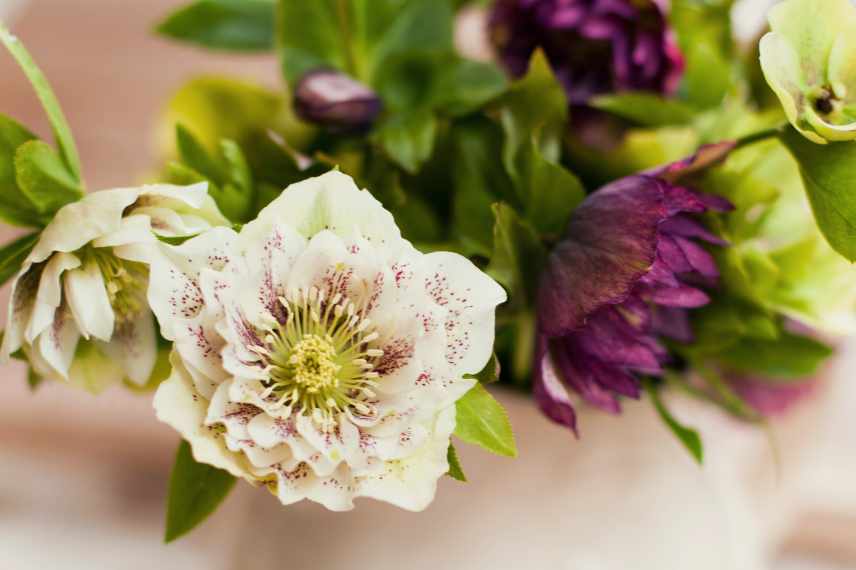
From November onwards, count on hellebores for long months to create pretty bouquets
Perennials for fragrant bouquets
Looking to create fragrant bouquets? No problem: opt for perennials renowned for their scent! This includes certain Dianthus, Phlox paniculata, and the ever-popular lavender, with its exquisite and distinctive fragrance.
Let’s not forget lily of the valley, with its green scent, or certain peonies like Paeonia lactiflora ‘Edulis Superba’. We should also mention curry plant, with its golden yellow flowering that releases a surprising curry-like aroma.
Combining perennials in bouquets
To create beautiful flower bouquets, here are some tips worth considering.
First of all, don’t hesitate to mix different types of plants. Combine your perennials with annuals (zinnias, cosmos, love-in-a-mist, sunflowers, strawflowers…), bulbs (tulips, irises, dahlias, arums…), climbing plants (sweet peas, wisterias…) and bushes (camellias, roses, lilacs, hydrangeas, Japanese quince, forsythias…). Also consider ornamental grasses, which will add lightness and a rustic touch to your bouquets.
Don’t overlook foliage, which brings a touch of greenery to highlight the flowering. They also help play with volumes and textures. Opt for ivy, eucalyptus, holly or Pittosporum leaves in particular.
Finally, remember fruits and attractive branches: contorted hazel, pussy willows, dogwoods with coloured wood, beautyberries, etc.
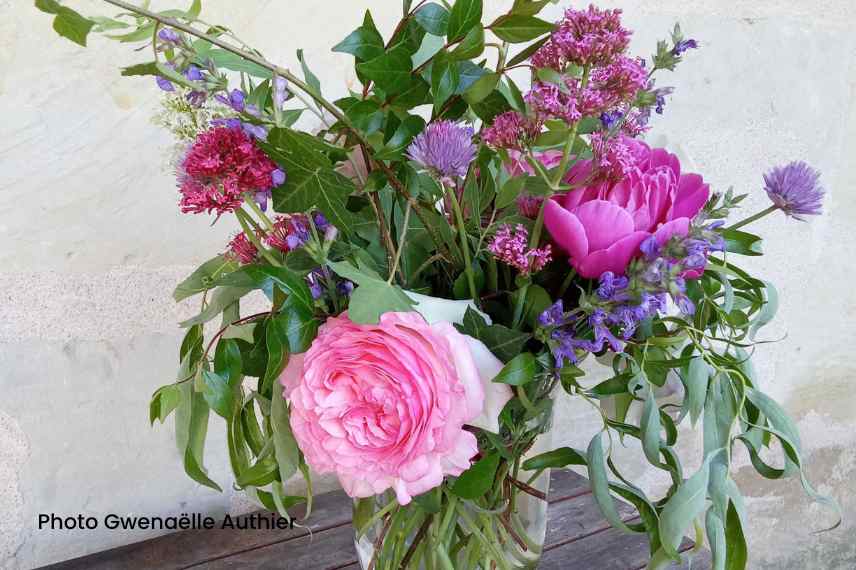
Combine flowering and foliage to distribute volumes and colours (photo Gwenaëlle Authier)
And to ensure you enjoy your perennial bouquets for longer, remember to:
- pick flowers early in the morning;
- choose some semi-open flowers or buds that will bloom in the vase;
- cut stems at an angle during harvest to increase the water absorption surface and keep flowers fresh longer;
- place the bouquet in a cool spot, away from direct sunlight;
- remove leaves at the bottom of the stem that might soak in water;
- use room-temperature water, to be changed regularly.
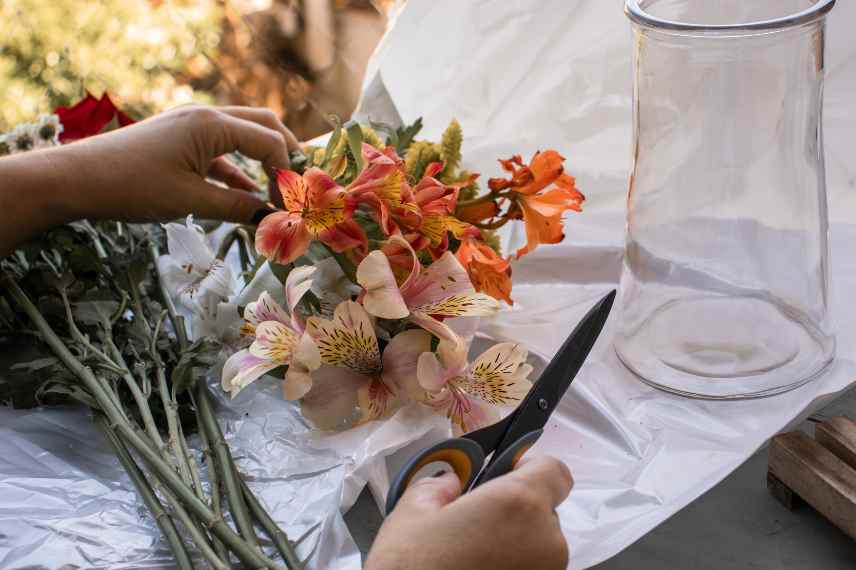
Remove leaves that would cloud the vase water
- Subscribe!
- Contents
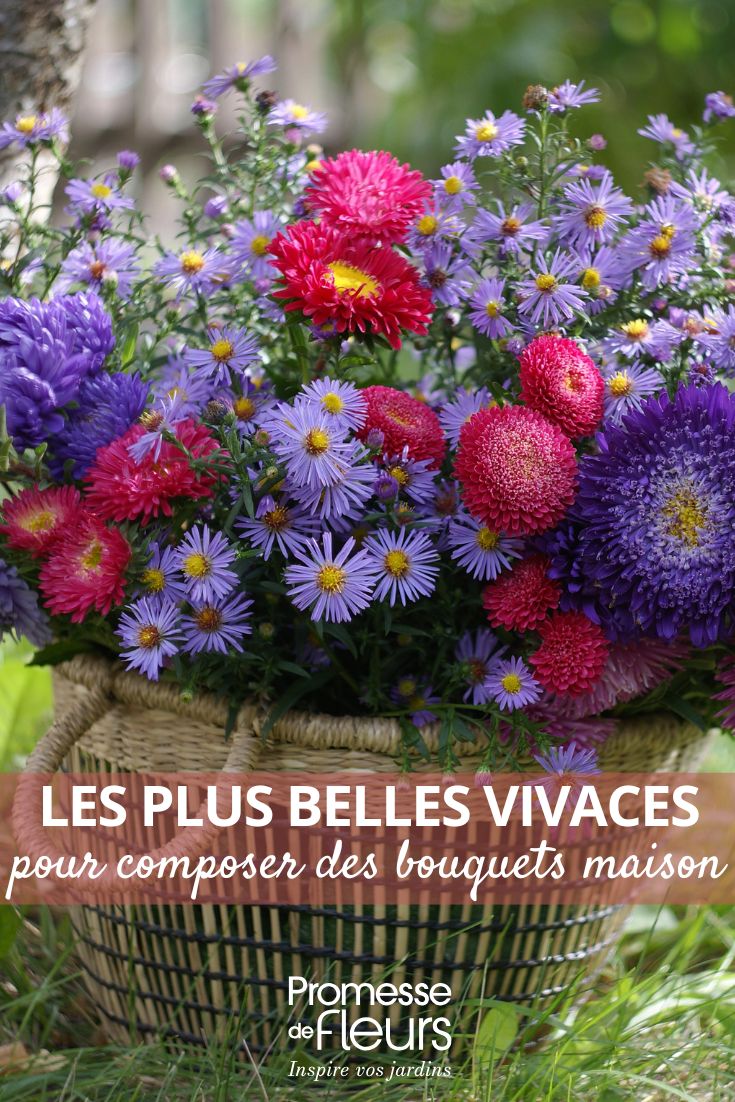































Comments